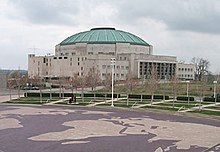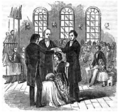
Back Portal:Mormonentum German Teemasivu:Mormonismi Finnish Portail:Mormonisme French Portal:Santos de ls Redadeiros Dies MWL Portal:Ruch świętych w dniach ostatnich Polish Portal:Santos dos Últimos Dias Portuguese
|
Welcome to the portal of The Latter Day Saint movement
Introduction The Latter Day Saint movement (also called the LDS movement, LDS restorationist movement, or Smith–Rigdon movement) is the collection of independent church groups that trace their origins to a Christian Restorationist movement founded by Joseph Smith in the late 1820s. Collectively, these churches have over 17 million nominal members, including over 17 million belonging to the Church of Jesus Christ of Latter-day Saints (LDS Church), 250,000 in Community of Christ, and several other denominations with memberships generally ranging in the thousands of members. The predominant theology of the churches in the movement is Mormonism, which sees itself as restoring again on Earth the early Christian church; their members are most commonly known as Mormons, though the LDS Church now rejects the use of that name. An additional doctrine of the church allows for prophets to receive and publish modern-day revelations. A minority of Latter Day Saint adherents, such as members of Community of Christ, have been influenced by Protestant theologies while maintaining certain distinctive beliefs and practices including continuing revelation, an open canon of scripture and building temples. Other groups include the Remnant Church of Jesus Christ of Latter Day Saints, which supports lineal succession of leadership from Smith's descendants, and the more controversial Fundamentalist Church of Jesus Christ of Latter-Day Saints, which defends the practice of polygamy. (Full article...) General images -The following are images from various Latter Day Saint movement-related articles on Wikipedia.
Selected articlePolygamy (called plural marriage by Latter-day Saints in the 19th century or the Principle by modern fundamentalist practitioners of polygamy) was practiced by leaders of the Church of Jesus Christ of Latter-day Saints (LDS Church) for more than half of the 19th century, and practiced publicly from 1852 to 1890 by between 20 and 30 percent of Latter-day Saint families. The practice of polygamy by Latter-day Saints has been controversial, both within Western society and the LDS Church itself. The U.S. was horrified by the practice of polygamy, with the Republican platform at one time referencing "the twin relics of barbarism—polygamy and slavery." The private practice of polygamy was instituted in the 1830s by Joseph Smith, founder of the Latter Day Saint movement. The public practice of polygamy by the LDS Church was announced and defended in 1852 by a member of the Quorum of the Twelve Apostles, Orson Pratt, at the request of Brigham Young, then president of the church. (Full article...)Selected location
Selected schismatic histories
The Church of Jesus Christ (Cutlerite) is a denomination of the Latter Day Saint movement headquartered in Independence, Missouri, United States. The church derives its epithet from its founder, Alpheus Cutler, a member of the Nauvoo High Council and of Joseph Smith's Council of Fifty. Cutler justified his establishment of an independent church organization by asserting that God had "rejected" Smith's organization—but not his priesthood—following Smith's death, but that Smith had named Cutler to a singular "Quorum of Seven" in anticipation of this event, with a unique prerogative to reorganize the church that no one beyond this group possessed. Hence, Cutler's organization claims to be the only legitimate Latter Day Saint church in the world today. Currently, it has only one branch, located in Independence. The Cutlerite church retains an endowment ceremony believed to date to the Nauvoo period, practices the United Order of Enoch, and accepts baptism for the dead, but not eternal marriage or polygamy. (Full article...)
OutlinesRelated portalsKey biographiesThe life of Joseph Smith from 1827 to 1830, when he was 22–25 years old, begins in late 1827, after Smith announced he had obtained a book of golden Plates buried in a hill near his home in Manchester, New York (near Palmyra village). Because of opposition by former treasure-seeking colleagues who believed they owned a share of the golden plates, Smith prepared to leave the Palmyra area for his wife's home town of Harmony, Pennsylvania (now Oakland). From late 1827 to the end of 1830, Smith would translate the golden plates, publish the Book of Mormon, and establish the Church of Christ. To translate the golden plates, Smith enlisted the assistance of Martin Harris, a wealthy Palmyra landowner who acted as Smith's scribe. To translate, Smith used seer stones (one set of which Smith later called the Urim and Thummim), and Smith said the stones showed him the translation. Translation ceased, however, when Harris lost 116 manuscript pages of uncopied text. Translation resumed in earnest when Smith was joined in May 1829 by a Smith family associate named Oliver Cowdery. Translation was completed near the end of July 1829, and the resulting manuscript was published as the Book of Mormon on March 26, 1830, in Palmyra. (Full article...)Selected image Teenagers from Mormon Fundamentalist polygamist families demonstrate at a pro-plural marriage rally in Salt Lake City in 2006. Following the 1890 Manifesto, the LDS Church began prohibiting the contracting of plural marriages, giving rise to the Mormon Fundamentalist movement and numerous Mormon Fundamentalist sects in the Latter Day Saint Movement.
Did you know (auto generated)
Selected Anniversaries
Selected quote
TopicsFeatured content
|
||||||||||

















